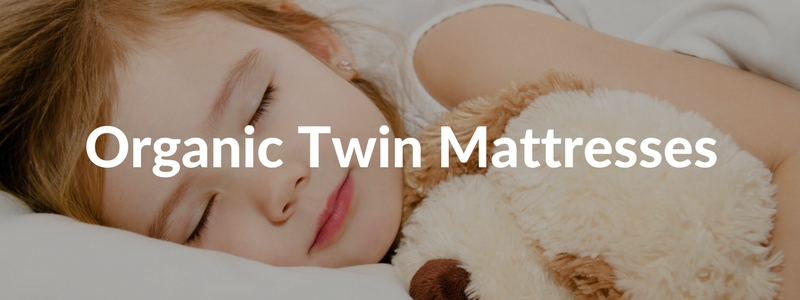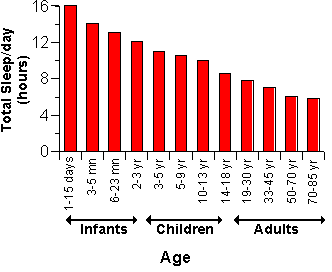No products in the cart.
Blog, Latex Mattresses, Mattresses
Organic Latex Mattresses for Children – Improving Sleep Quality with Kids
Choosing the Best Children’s Organic Latex Mattress
Just like our adult latex mattresses, our twin and full-size latex mattresses are completely customizable.
Some important facts:
- Twin latex mattresses come in three different heights which are made up of 3-inch latex layers.
- 7 inch is two layers.
- 10 inch is three layers.
- 13 inch is four layers (typically this size is unnecessary for a child, however you might need this thickness for a particular bed frame.
- Each layer’s firmness can be customized into the perfect custom latex mattress for their needs.
- You can choose between 100% natural Talalay and 100% Natural Dunlop latex for each layer that makes up their latex mattress.
- When your child grows up and their weight and sleep needs change, you can add another firmer or different layer without needing to buy a completely new mattress.
Our Top Recommendations for Children’s Organic Latex Mattresses
Click this link for a custom recommendation based on your child’s weight and sleep needs. Feel free to email (cs@sleepingorganic.com) or call to speak with one of our Sleep Specialists.
Our phone number is: 1-800-625-4042.
Our most recommended twin/full latex mattress configurations for children are:
7 Inch Sprout -Two-layer Latex Mattress (most popular for kids)
Top layer: Dunlop medium
Bottom layer: Dunlop firm
10 Inch Leaf – Three-layer Latex Mattress
Top layer: Dunlop soft or Talalay soft
Middle layer: Dunlop medium
Bottom layer: Dunlop firm
13 Inch Tree -Four-layer Latex Mattress
Top layer: Dunlop soft or Talalay soft
Middle layer: Dunlop medium
Middle layer: Dunlop firm
Bottom layer: Dunlop extra firm
Building the Best Organic Twin/Full Size Latex Mattress
If you’re ready to look at some options for a twin- or full-size latex mattress for your child, click here.
Besides durability, and organic natural fabrics like cotton and wool, one of the biggest benefits of Sleeping Organic’s good mattress is customizability. And when you’re choosing which latex mattress to buy for your child, it’s important to consider how their bodies will change over the next 2, 5, or even 10 years.
Because you can adjust the layers in our latex mattress, you’re able to order the layers to reflect their body’s current needs without sacrificing what they’ll need in the future. As their sleep needs change you can adjust the mattress’s firmness by moving and changing the latex layer configuration. In the end, you save money because you won’t have to buy a completely new bed as they get older!
On this topic, mattress firmness is the variable we’re mostly speaking to.
What firmness is Safe for Kids’ Organic Latex Mattresses?
Extra firm or firm mattresses are best for kids because of their developmental needs. But a medium firmness will feel firm to a child as they are so light in weight.
Starting at a young age, babies need as firm of a mattress as possible because they sleep mostly on their backs. The firmness helps keep the infant’s spine aligned at night, which is critical for development. And this need does not go away when your child moves out of the infant stage!
Since kids spend 10+ hours a night in bed, their spine needs to be properly aligned or there will be negative effects on growth. This is why we always recommend firm latex mattresses for kids, especially when your child is under 13 years old.
The beauty of our twin/full-sized latex mattress is that it’s built in layers, so it can be adjusted when your child’s sleep needs change.
The Research on the Importance of Sleep for Growing Children
Children need lots of sleep, it’s no secret!
A well-rested kid is a happy kid, right?
But how much sleep do kids need?
And what else about their sleep environment matters?
According to the University of Michigan Medical School, children need between 9.5 and 11.5 hours of sleep every night, a number that’s backed up by the University of Washington in the graph below:
We know the amount of sleep is important for kids, but their quality of sleep matters too! And it’s a children’s wellness tip that certainly isn’t talked about enough…
Children Don’t Just Need More Sleep, They Need Better Sleep
This graph shows the percentage of REM sleep that an average infant, child, and adult each get over the course of one night:
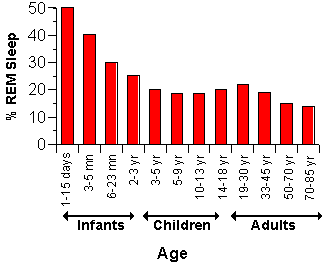
As you can see, babies go through the most REM cycles while children aged 3-14 go through the least amount of REM cycles (sometimes referred to as deep sleep) compared to any other age bracket.
According to Harvard University, “sleep cycles, composed of REM and NREM sleep, last for about 50 minutes in children and 90 minutes in adults.”
This is why children need more total sleep time. Because they spend less time in REM sleep, simply spending more time sleeping helps maximize the likelihood your child will get through more REM cycles.
And the more REM cycles your child goes through, the more well-rested he or she will feel (and the easier your day will feel as a parent).
As a parent, it’s important to make sure your child gets the best night’s sleep possible, right?
But with all the things on your to-do list, how can you make this happen with as little day-to-day effort as possible?
Is an organic twin mattress your answer?
Does a Non-Toxic Kid’s Bedroom Have Any Real Benefits?
We agree on the importance of sleep for kids. From infant stages, through toddlers, and onto teenagers, it’s critical for proper development. But where does the bedding your children sleep on come into play?
We can agree that comfort matters. If your kid’s mattress isn’t comfortable, they’ll have a harder time falling asleep and staying asleep. But beyond this… As a parent, how can you choose what’s important in a twin mattress for your child and what’s just marketing fluff?
Do Mattresses with Chemicals Have Negative Behavioral Side Effects?
The short answer is (most likely) yes.
According to Molly Kile, a professor at Oregon State University’s College of Public Health and Human Sciences, there’s “a significant relationship between social behaviors among children and their exposure to widely used flame retardants.” Molly is an environmental epidemiologist.
You can read the full results of her research study, here:
Cross-sectional study of social behaviors in preschool children and exposure to flame retardants
Citation: Lipscomb, S.T., McClelland, M.M., MacDonald, M. et al. Environ Health (2017) 16: 23. doi:10.1186/s12940-017-0224-6
Lower Immune Systems Leave Children More Prone to Foreign Bodies
As Dr. Dave Staukus states in his article about boosting children’s immune systems, the normal rate for children to experience upper respiratory illness is 6-10 times per year. This is much higher than the average adult for a few reasons.
First, children are exposed to antigens (bacteria, virus, parasites, etc) more often than adults.
Second, children’s immune systems aren’t as developed because they haven’t been exposed to enough bacteria in their life.
White blood cells, particularly the neutrophils, macrophages, and lymphocytes get credit for the discovery and removal of toxins. And after your body (or your child’s) has recovered, the immune system ‘remembers’ how it fought. This is why it’s easier to beat many illnesses a second time around.
Problem is, some bacterias, viruses, and in our case, harmful chemicals have stronger effects on the body than they’re able to fight off.
This brings us back to Molly Kile’s research…
Beware of Toxic Chemicals, Materials, and Unhealthy Additives
Molly Kile’s study exposed multiple groups of children to varying levels of hazardous fire-retardant chemicals, particularly brominated flame retardants (BDEs) and organophosphate flame retardants (OPFRs). The result was as follows, a direct quote from her study:
“Children with higher organophosphate flame-retardant exposure were rated by their preschool teachers to show less responsible behavior and more externalizing behavior problems. Children with higher exposure to brominated flame retardants were rated by their preschool teachers as less assertive.”
While it may sound safer to have your kid’s mattress be completely resistant to fire, the additives involved in making the bed fire-safe render the end product far from pure, and potentially harmful to you and your child.
Whether you’re in the market for a latex, wool, or memory foam mattress, the toxicity of chemicals like polybrominated diphenyl ethers (PBDEs), volatile organic compounds (VOCs), phthalates, and additives proven to be harmful should be considered before ordering your new bed.
Whether you buy from a conventional mattress firm or an online brand (like Sleeping Organic), there are a few green certifications you should keep in mind. To help you choose a certified all-natural latex mattress that doesn’t contain formaldehyde or polyurethane, we’ve listed each certification to look out for below.
Latex Mattress Certifications and Standards You Can Trust
Any manufacturer or retailer you’ll buy a mattress from should be forthcoming about safety certifications and organic certifications for the product you’re looking at. I emphasize should because this isn’t always the case. Like with health food, many brands get away with surface-level claims that sneak by consumers who are vulnerable and uninformed.
As a general rule, here are the certifications you can trust when buying healthier twin latex mattresses:
- Oeko-Tex
- GOLS
- GOTS
- Green America (certified companies)
Considering Alternative Sizes
A common question we get from parents buying an organic latex mattress for their child relates back to size. And though this article is about twin and full size mattresses for kids, we’d be remiss if we didn’t mention the other options available for you.
Size of a Normal Twin Bed

Twin-sized mattresses are 38” in width and 75” long.
Planning Ahead for College
Some (but not all) colleges and universities allow students to bring their own mattress to school, so it’s worth considering this possibility now. If your child’s school allows it, they’ll get a much more comfortable sleep on a latex mattress than they would with the standard university bed. Buying an organic twin XL mattress is important here because that’s the size of most bed foundations provided by your son or daughter’s school will be that size.
Twin XL Mattress Dimensions

Twin XL mattresses are 38” in width like normal twins, but offer an extra 5” of leg room because they’re 80” long.
More Room for Sleeping
If you’re starting fresh and buying a complete bed set (mattress, foundation, mattress protector, sheets) for your child, then it’s also worth considering a full-sized organic mattress. Because our mattress will last 20+ years, a full size means they’ll not only be more comfortable as they grow into teenagers, but it also becomes possible for them to grow into it after they graduate from college. While it’s unlikely they’ll want a twin-sized mattress when they move out of the family house, a full mattress may be acceptable.
And just like with the twin XL option, full mattresses should be considered if your children are taller than average. They’ll love the extra foot room!
Full Mattress Dimensions

Full size beds are 53” in width, which is about 12 inches wider than a twin mattress. They’re 75” long, which is the same length as your normal twin bed, but 5 inches shorter than a twin xl, which is an ideal sized bed for taller children.
Filling Out Your Child’s Non-Toxic Bedroom
Organic latex mattresses are only part of a bedroom free of harsh chemicals. Many parents in the market for new latex mattresses for their kids also choose to make the whole bed set completely natural. Doing so involves a few key bedding products:
Strong Solid Wood Latex Mattress Foundation
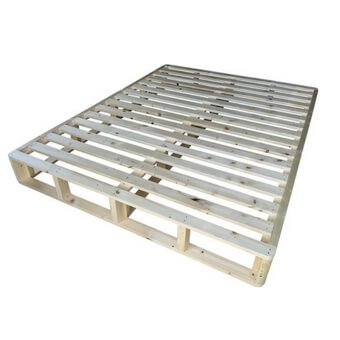
You don’t need a box spring for your mattress. In fact, we highly recommend against it. Besides the fact they’re a common cause of bedroom mildew growth, box springs aren’t supportive enough for latex foam mattresses. In fact, laying your child’s twin latex mattress on top of a box spring nullifies most benefits you’ll get from buying them a latex mattress all together!
More sustainable, healthy alternatives include wood foundations, platform beds, and adjustable beds. For most parents, a solid wood foundation will be the best choice. It’s durable enough to withstand bedroom play time and breathable enough for you to avoid the common downsides of box springs. Plus, it’s one of the more affordable mattress foundations out there!
Waterproof Mattress Protector
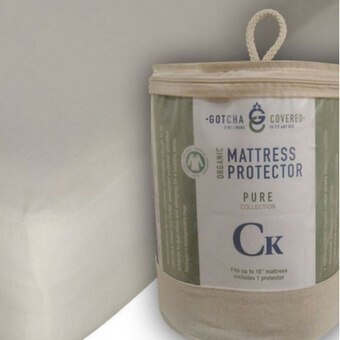
Your child’s mattress can be a messy place. It’s a fact of life. And depending on how old they are, your child’s bed may get messier than you’d like it to…
One of the best returns on investment for these tough moments is a waterproof mattress protector. Our most popular is made from 100% cotton and feels like a jersey t-shirt. So, when the spills pop up, all you’ll need to do is wash the protector instead of worrying about how you’ll quickly dry out your kid’s mattress.
Standard Size Natural Latex Pillows
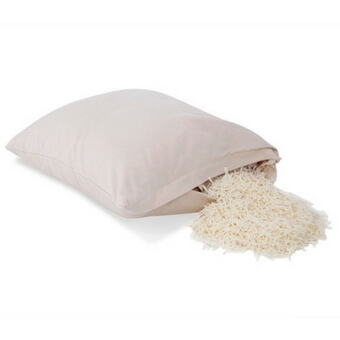
When you buy your child’s organic twin or full latex mattress through Sleeping Organic, we’ll give you one standard-sized shredded latex pillow at no additional cost.
These pillows are great for kids because they’re completely adjustable based on how your child sleeps. You just remove some latex stuffing to decrease the loft.
Organic Cotton Kid’s Sheets
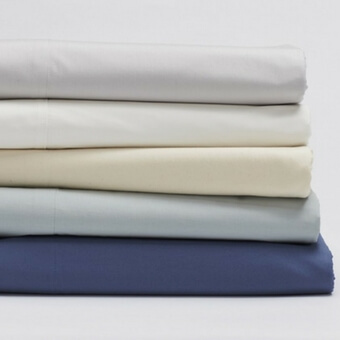
We’ve covered organic twin mattresses, full mattresses, latex mattress foundations, mattress protectors, and pillows. The last piece of bedding needed to round out your child’s non-toxic bedroom is a set of organic sheets.
Beyond being made without any toxins or harmful chemicals, organic sheets are extremely comfortable.
Your child will feel nice and cozy as they fall asleep in their new latex mattress.
So, will an organic bed really improve your child’s sleep?
If we can agree that the toxins and toxic chemicals present in many mattresses hurt your child’s sleep, then we can also agree that there are strong indications that point to an organic latex mattress helping your child sleep better at night.
And if you’re considering buying an organic twin or full latex mattress soon, mention this article when checking out to get an additional 5% off your children’s mattress to help make the investment more affordable for you and your family.
